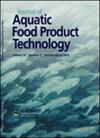印尼盐煮长尾金枪鱼(Thunnus sp.)和东部小金枪鱼(Euthynnus sp.)加工过程中产组胺菌的鉴定
IF 1.3
4区 农林科学
Q4 FOOD SCIENCE & TECHNOLOGY
引用次数: 0
摘要
摘要从印尼海域捕捞的长尾金枪鱼和东方小金枪鱼中分离出组氨酸产生菌(HPB),并将其加工成盐水水煮鱼(SBF)。在尼文琼脂上分离嗜中温菌和嗜冷菌,筛选组氨酸脱羧酶活性和hdc基因的存在,然后定量组胺的产生。HPB共鉴定出6个属:肠杆菌属、欧文氏菌属、哈夫尼亚菌属、克雷伯菌属、沙雷氏菌属和志贺菌属。在稳定生长阶段,嗜温分离株产生的组胺大约是嗜冷分离株的400倍。hdc阳性分离株的比例随着SBF处理步骤的增加而增加,这表明食品安全措施对最大限度地减少HPB生长和组胺产生的重要性。本文章由计算机程序翻译,如有差异,请以英文原文为准。
Characterization of Histamine-Producing Bacteria Isolated During Processing of Indonesian Salted-Boiled Longtail (Thunnus sp.) and Eastern Little Tuna (Euthynnus sp.)
ABSTRACT Histamine-producing bacteria (HPB) were isolated from Longtail and Eastern Little tuna harvested from Indonesian waters and processed as salted-boiled fish (SBF). Mesophilic and psychrophilic bacteria were isolated on Niven’s agar, screened for histidine decarboxylase activity and the presence of the hdc gene, and then histamine production was quantified. Six genera of HPB were identified: Enterobacter, Erwinia, Hafnia, Klebsiella, Serratia and Shigella. At stationary growth phase , mesophilic isolates produced approximately 400 times more histamine than psychrotrophic isolates. The proportion of hdc-positive isolates increased with SBF processing steps, indicating the importance of food safety measuresto minimize HPB growth and histamine production.
求助全文
通过发布文献求助,成功后即可免费获取论文全文。
去求助
来源期刊
CiteScore
3.50
自引率
6.20%
发文量
77
审稿时长
7 months
期刊介绍:
The Journal of Aquatic Food Product Technology publishes research papers, short communications, and review articles concerning the application of science and technology and biotechnology to all aspects of research, innovation, production, and distribution of food products originating from the marine and freshwater bodies of the world. The journal features articles on various aspects of basic and applied science in topics related to:
-harvesting and handling practices-
processing with traditional and new technologies-
refrigeration and freezing-
packaging and storage-
safety and traceability-
byproduct utilization-
consumer attitudes toward aquatic food.
The Journal also covers basic studies of aquatic products as related to food chemistry, microbiology, and engineering, such as all flora and fauna from aquatic environs, including seaweeds and underutilized species used directly for human consumption or alternative uses. Special features in the journal include guest editorials by specialists in their fields and book reviews covering a wide range of topics.

 求助内容:
求助内容: 应助结果提醒方式:
应助结果提醒方式:


